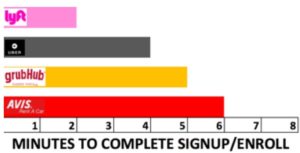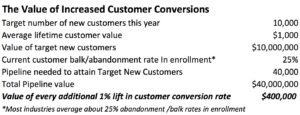Lots of organizations talk about revenue goals and plans and pipelines. Salesforce.com is counting on it.
Today, for an increasing number of companies, it’s less about relationship selling, or even what’s described in The Challenger Sale – sales happen at the point of enrollment, and in growing numbers, that’s online.
What’s shocking is that if you search on customer conversion rates, 25% is a common statistic you will find for the rate at which customers give up, abandon, or balk while trying to become a customer. As you might expect, there are a lot of reasons for that – one of them is that it just takes to long. People get tired of entering their name and address and credit card and verifying their e-mail and all of that. Here’s a graph of an anecdotal experience of how long it took to enroll in Lyft, Uber, Grubhub, and Avis.
Lyft is a great experience. They ask you to verify your cell phone within the enrollment application (so you don’t toggle over to e-mail and risk getting distracted). Grubhub is very smart because they start with a food order – so if you are hungry, even though it takes a while, you are probably very motivated to stick with it.
An important thing to note on this is that with all of these common consumer services – whether you use them or not – they are setting the standard for what people will expect in their next enrollment experience. That’s one of the big shifts that is going on – whereas people used to have their expectations set within a given industry – comparing restaurant to restaurant or airline to airline, or what have you, online experiences set expectations that often traverse industries. So you might not think you need to compare your enrollment with Lyft because you aren’t in the transportation industry – don’t be so quick to dismiss that comparison.
Here’s some simple math on the value of boosting conversion rates (happy to send you the Excel calculator if you would like it).
A $400,000 boost in top line revenue for every 1% lift in customer conversion on a $10million target – it’s all simple math you can adjust for your own target. There’s another chart that compares all of the different things organizations “need” to finish your enrollment – and that’s also an interesting comparison which I am happy to share.
The important point here is that speed is critical. It’s not the whole pie chart of why customers walk away – but it’s a big slice of the pie. There are three ways to change your enrollment process to speed it up.
- Make it more fun. If something is fun – people don’t notice that it takes time. People have had it with IDs and passwords – and younger customers love taking selfies all day long. So as facial recognition software has matured, we are finally starting to get away from the tedious ID/password, and places like AuthenticID have great solutions for that.
- Reduce what ask for. One of the reasons Lyft is so fast is they are smart about what’s required to enroll. Do you really need their mailing address and their credit card and their birth date right now? Some do, but most do not. Even if they are buying a product from you – you could wait until you are ready to ship it before you make them pay. Smarter companies think this through.
- Do what Redbox does – break up the things that take time. Redbox is the instant $1 movie rental kiosk in many grocery stores (usually next to the Coinstar). They have you choose your movie first because it creates a sense of reward right away – and then they ask for your credit card information. One of the reasons they do that is because it takes them some time to pull the movie out of the back of the machine to present it to you. So instead of having you wait for that – they have you do something else so you aren’t standing around looking at an hourglass. So look at the tasks that take time and break them up where you can.
- Commit them emotionally right away. The Grubhub example of having people place an order is the best. It creates the sense that someone has already started making your pizza or sandwich or wings – so you have to finish or you will disappoint someone on the other end.
That’s four things you can do. We are collecting research on these before/after customer conversion boost efforts – send me your data and your anecdotes and I will do a follow up post on this later in the year.


Leave a Reply